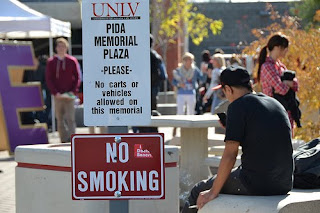
A lack of tobacco control policies has earned Napa County an F on its yearly report card from the American Lung Association. This is the fourth year the county has received a failing grade.
The association’s annual State of Tobacco Control report measures cities and counties for the number of ordinances that regulate smoke-free outdoor environments, smoke-free housing and reduce the sale of tobacco products to minors.
Napa County has only a few local anti-smoking ordinances — bans on smoking in parks in Napa, American Canyon and St. Helena.
Pam Granger, a tobacco programs manager for the lung association, blamed elected officials for not passing more laws restricting secondhand smoke and tobacco sales.
“Elected officials have done very little to ensure clean and healthy air for their visitors and residents,” Granger said, adding that she hoped clean and healthy air would become a priority for the county in 2012.
“Tobacco policies are a really cheap way to improve the lives of thousands of people,” she said.
Peggy Klick, director of Community Action Napa Valley’s Tobacco Education and Quit Smoking programs, said she was not surprised by the lung association’s report.
Policies take time to develop, and elected officials are not to blame, Klick said. She faulted the report for not taking Napa’s voluntary efforts into account.
“The intention of the American Lung Association in publishing these grades is to motivate communities and elected leaders to take action. But when the community sees an F grade, they associate that with overall failure,” Klick said. “We want to make it clear to the Napa community that the Tobacco Education Program continues to make effective progress to decrease secondhand smoke exposure in Napa County by collaborating with partner organizations and engaging the support of city councils and the Board of Supervisors.”
Beginning in 2001, the Tobacco Education Program developed a campaign to increase the number of voluntary smoke-free outdoor dining areas. By the end of 2004, 25 restaurants established formal, written policies related to non-smoking outdoor areas, Klick said. The latest numbers show that a total of 30 restaurants have smoke-free outdoor dining policies, she said.
Napa County also has reduced its tobacco sales rate to minors. Through a local merchant education campaign, the rate was reduced from 60 percent in the early 2000s to 5 percent by 2007.
It was agreed, with the consultation of the California Tobacco Control Program, that such strong merchant compliance made it unnecessary to develop an ordinance, Klick said. Napa’s tobacco education program will be looking into tobacco retail licensing operations again in 2013, she said.
From 2007 to 2010, seven apartment complexes in Napa County developed smoke-free policies for all units and common outdoor areas, Klick said.
Senate Bill 332, which went into effect earlier this month, may lead to even more apartment complexes developing smoke-free policies. The bill gives landlords the specific power to ban smoking not only inside rental housing, but from the surrounding grounds.
In 2010, Napa County parks became smoke-free, with the exception of an overnight camping area at Lake Berryessa, which has a designated smoking area. In 2009, the city of Napa adopted an ordinance making all parks within city limits completely smoke-free.
American Canyon and St. Helena have policies that ban smoking in play and sport areas, but the parks are not completely smoke-free. Klick said the local tobacco program has been working with the St. Helena Parks and Recreation Commission and will request approval for a smoke-free park and recreation ordinance from the St. Helena City Council in February.
All of these voluntary efforts have been recognized by the California Department of Health Tobacco Control Section, which also grades the county. In 2011, the state program gave Napa an A for its efforts to reduce secondhand smoke and tobacco sales.
The American Lung Association’s county report was issued the same day as its national report, which evaluates federal and state policies. In 2011, a total of 45 California cities and counties adopted new tobacco control policies.
But another 355 cities and counties — 66 percent of all jurisdictions in the state — received an F.
“Once a national leader in tobacco control policies, California’s efforts are now lagging,” according to the lung association.
The state earned failing grades for inadequately funding tobacco prevention and control programs and for its low cigarette tax. California currently ranks 33rd among the 50 states and the District of Columbia for its 87-cents-per-pack tax, far below the national average of $1.46.
In June, voters will have the choice of whether or not to pass the California Cancer Research Act, which would increase the state’s tobacco tax by $1 per pack and dedicate revenues to the treatment and prevention of lung disease, heart disease and stroke, cancer and other tobacco-related illnesses. The measure also would triple state funding to more than $855 million for tobacco prevention and cessation efforts, said Jane Warner, president and CEO of the American Lung Association in California.
“Now is the time for California to raise the grade,” Warner said.
Комментариев нет:
Отправить комментарий